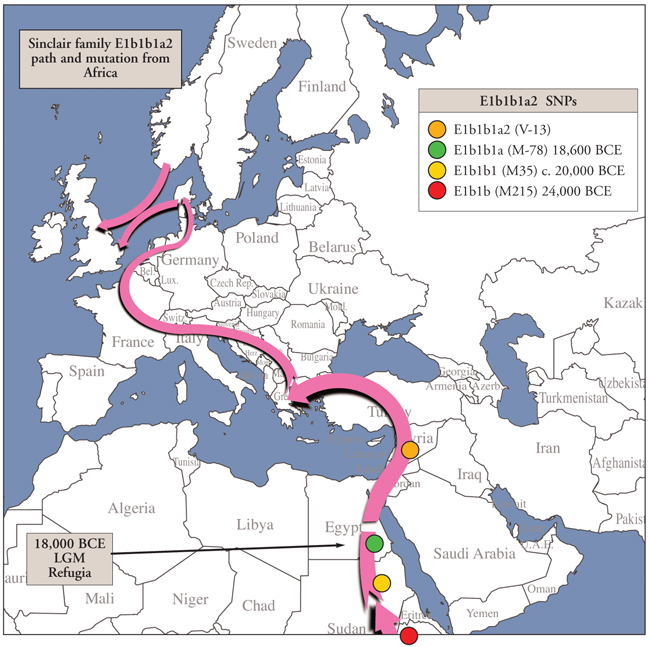Sinclair DNA - E1b1 - Early Path Through Time
Click any one of these to follow the E1b1 lineage's complete path through time
 |
 |
 |

Looking at the SNPs
above, you can see that this group moved very slowly out of Africa,
then extremely rapidly once they got to Europe. The timing of their
arrival into Western Europe is somewhat debated, but they were in
Normandy far in advance of the time our ancestors were taking the
surname from the land.
A Broad Look at the E1b1 Path
Through Time
If this section seems short compared to the R1b section, our E1b1 participants should be happy. It simply means that your haplogroup is more clearly understood. And, not being members of the AMH haplogroup, yours' is a far easier set of results to compare with other data.
Two
of the three branches of haplogroup E, the major clades E1 and E2, have
been
found mostly on the African continent, where their distribution has
been
analyzed in detail (Underhill et al. 2000; Cruciani et al. 2002). The
third
branch, the clade E3 (now E1), defined by the mutation P2, is the only
one that
has been found in large numbers in Europe and in western
Asia 118
As
of this writing, we have two participants who fall within the
Haplogroup
formerly known as E3b. Their specific markers are characterized by M35+
V36+
and they're specifically now known as Haplogroup E1b1b.
The
first three clades of this Haplogroup all mutated in Northeastern
E1b1
E1b1b
E1b1b1
All
these groups probably first mutated in Africa between 20,000 and 47,500
years
ago. This group stayed in Africa far longer than our R1b or I1
Haplogroups. The
mutation that established E-M35 (E1b1b1a2) participants was estimated
by
Criciani et al. (in 2008) at 24,000 years ago.
Interestingly,
our E1b1 participants both show a "null" value on DYS425. A value of
"null" (zero) for any marker means that the lab reported no result
for this marker. All cases of this nature are retested multiple times
by the
lab to confirm their accuracy. Mutations
causing null values are infrequent, but are passed on to offspring just
like
other mutations,
Steven
C. Bird has done a fascinating study of the E1b1 Haplogroup in which he
compares
standard FTDNA alleles of subjects in given geographies to arrive at
geographic
locations of specific subclades of E1b1.
Bird's
hypothesis that members of the E1b1(a2) haplogroup migrated to
Britain from
the Balkans with the Roman military during the first through third
centuries as members of auxiliary military units or as members of the
regular
Roman
legions, is supported by genetic, archaeological and historical
evidence. I've
seen many such sources, but Bird's was new to me in 2008. However, it
seems believable
based on
the Anglo-Saxon studies of R1b.
There
is some reason to believe that our E1b1b participants came to the U.K.
from the
Roman provinces of Thracia and Moesia.119
Steven C. Bird did a
geographical
survey of existing families of E1b1b origins in the U.K. and studied
their
markers. The set of markers our participants display plus the "null"
marker on DYS425 were the clinchers. Our

R1b | E1b1 | I1 | R1a | S21
Home | Contact | Join Google Discussion Group
